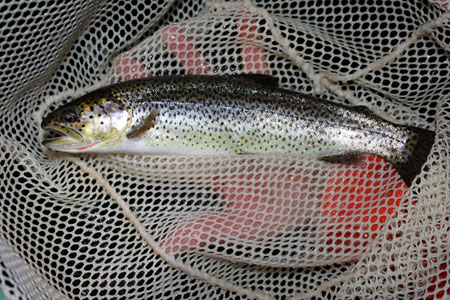Cutthroat Trout
(Oncorhynchus clarkii)
Species Profile
Did You Know?
Coastal cutthroat trout can hybridize with rainbow trout and produce fertile offspring.
General Description
Coastal cutthroat trout occur as sea-run or freshwater-resident forms in streams and lakes along the coastal range from lower Southeast Alaska to Prince William Sound and are the most common trout species in the region. The freshwater-resident form lives in a wide variety of habitats, from small headwater tributaries and bog ponds to large lakes and rivers. Sea-run cutthroat trout are usually found in river or stream systems with accessible lakes, mostly south of Fredrick Sound. In some watersheds, like the Taku River, the two forms are found together. The extent of breeding between the two forms is unknown, and the reason that some fish migrate to sea while others stay in fresh water remains an interesting question.
Juveniles
Juveniles are 1–6 inches long and silver or yellowish to olive in color, with about 10 oval parr marks overlain with small black spots. Some juveniles will have a faint red or pink coloration along the lateral line and on the gill covers. The characteristic red or yellow slashes under the jaw begin to develop when a juvenile reaches approximately 3–5 inches in length.
Adults
Adult coloration varies widely with habitat and life history: freshwater-resident fish living in small ponds or streams are typically 6–16 inches long, golden yellow with profuse black spotting on the body, head, and fins, and have vivid red slash marks under each jaw bone (hence the name cutthroat). Coastal cutthroat trout living in large landlocked lakes can exceed 24 inches in length, are uniformly silver with black spots, rosy gill covers, and faint slash marks under the jaw. Sea-run cutthroat trout are smaller, seldom more than 18 inches long. They are bluish-silver with dark or olive backs and less conspicuous black spotting; the characteristic slashes are faint yellow. With prolonged residence in fresh water and progression toward spawning condition, sea-run coastal cutthroat trout will darken up and closely resemble freshwater-resident pond- and stream-type fish.
Similar Species
Lack of distinct slash marks in sea-run and lake-resident forms has led anglers to confuse these fish with rainbow trout. Cutthroat trout can most often be positively distinguished from rainbow trout (though with difficulty) by the presence of minute teeth between the gills behind the base of the tongue.
The fact that cutthroat trout and rainbow trout often occupy the same habitats leads to their occasional hybridization. This hybridization can, make identifying cutthroat trout confusing, as hybrid fish are intermediate in appearance.


